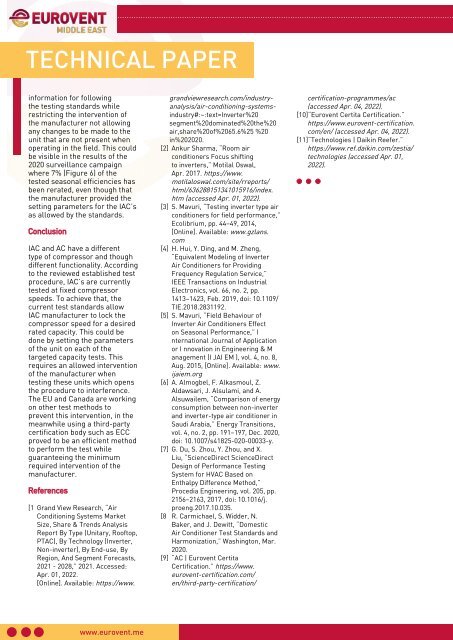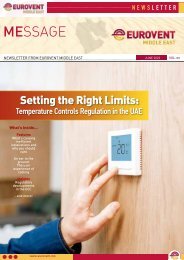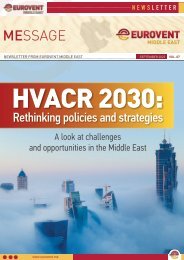EME Newsletter MEssage #1/2022
HVACR Industry news from Eurovent Middle East
HVACR Industry news from Eurovent Middle East
Create successful ePaper yourself
Turn your PDF publications into a flip-book with our unique Google optimized e-Paper software.
NEWSLETTER<br />
TECHNICAL PAPER<br />
information for following<br />
the testing standards while<br />
restricting the intervention of<br />
the manufacturer not allowing<br />
any changes to be made to the<br />
unit that are not present when<br />
operating in the field. This could<br />
be visible in the results of the<br />
2020 surveillance campaign<br />
where 7% (Figure 6) of the<br />
tested seasonal efficiencies has<br />
been rerated, even though that<br />
the manufacturer provided the<br />
setting parameters for the IAC’s<br />
as allowed by the standards.<br />
Conclusion<br />
IAC and AC have a different<br />
type of compressor and though<br />
different functionality. According<br />
to the reviewed established test<br />
procedure, IAC’s are currently<br />
tested at fixed compressor<br />
speeds. To achieve that, the<br />
current test standards allow<br />
IAC manufacturer to lock the<br />
compressor speed for a desired<br />
rated capacity. This could be<br />
done by setting the parameters<br />
of the unit on each of the<br />
targeted capacity tests. This<br />
requires an allowed intervention<br />
of the manufacturer when<br />
testing these units which opens<br />
the procedure to interference.<br />
The EU and Canada are working<br />
on other test methods to<br />
prevent this intervention, in the<br />
meanwhile using a third-party<br />
certification body such as ECC<br />
proved to be an efficient method<br />
to perform the test while<br />
guaranteeing the minimum<br />
required intervention of the<br />
manufacturer.<br />
References<br />
[1 Grand View Research, “Air<br />
Conditioning Systems Market<br />
Size, Share & Trends Analysis<br />
Report By Type (Unitary, Rooftop,<br />
PTAC), By Technology (Inverter,<br />
Non-inverter), By End-use, By<br />
Region, And Segment Forecasts,<br />
2021 - 2028,” 2021. Accessed:<br />
Apr. 01, <strong>2022</strong>.<br />
[Online]. Available: https://www.<br />
grandviewresearch.com/industryanalysis/air-conditioning-systemsindustry#:~:text=Inverter%20<br />
segment%20dominated%20the%20<br />
air,share%20of%2065.6%25 %20<br />
in%202020.<br />
[2] Ankur Sharma, “Room air<br />
conditioners Focus shifting<br />
to inverters,” Motilal Oswal,<br />
Apr. 2017. https://www.<br />
motilaloswal.com/site/rreports/<br />
html/636288151341015916/index.<br />
htm (accessed Apr. 01, <strong>2022</strong>).<br />
[3] S. Mavuri, “Testing inverter type air<br />
conditioners for field performance,”<br />
Ecolibrium, pp. 44–49, 2014,<br />
[Online]. Available: www.gzlans.<br />
com<br />
[4] H. Hui, Y. Ding, and M. Zheng,<br />
“Equivalent Modeling of Inverter<br />
Air Conditioners for Providing<br />
Frequency Regulation Service,”<br />
IEEE Transactions on Industrial<br />
Electronics, vol. 66, no. 2, pp.<br />
1413–1423, Feb. 2019, doi: 10.1109/<br />
TIE.2018.2831192.<br />
[5] S. Mavuri, “Field Behaviour of<br />
Inverter Air Conditioners Effect<br />
on Seasonal Performance,” I<br />
nternational Journal of Application<br />
or I nnovation in Engineering & M<br />
anagement (I JAI EM ), vol. 4, no. 8,<br />
Aug. 2015, [Online]. Available: www.<br />
ijaiem.org<br />
[6] A. Almogbel, F. Alkasmoul, Z.<br />
Aldawsari, J. Alsulami, and A.<br />
Alsuwailem, “Comparison of energy<br />
consumption between non-inverter<br />
and inverter-type air conditioner in<br />
Saudi Arabia,” Energy Transitions,<br />
vol. 4, no. 2, pp. 191–197, Dec. 2020,<br />
doi: 10.1007/s41825-020-00033-y.<br />
[7] G. Du, S. Zhou, Y. Zhou, and X.<br />
Liu, “ScienceDirect ScienceDirect<br />
Design of Performance Testing<br />
System for HVAC Based on<br />
Enthalpy Difference Method,”<br />
Procedia Engineering, vol. 205, pp.<br />
2156–2163, 2017, doi: 10.1016/j.<br />
proeng.2017.10.035.<br />
[8 R. Carmichael, S. Widder, N.<br />
Baker, and J. Dewitt, “Domestic<br />
Air Conditioner Test Standards and<br />
Harmonization,” Washington, Mar.<br />
2020.<br />
[9] “AC | Eurovent Certita<br />
Certification.” https://www.<br />
eurovent-certification.com/<br />
en/third-party-certification/<br />
certification-programmes/ac<br />
(accessed Apr. 04, <strong>2022</strong>).<br />
[10]“Eurovent Certita Certification.”<br />
https://www.eurovent-certification.<br />
com/en/ (accessed Apr. 04, <strong>2022</strong>).<br />
[11]“Technologies | Daikin Reefer.”<br />
https://www.ref.daikin.com/zestia/<br />
technologies (accessed Apr. 01,<br />
<strong>2022</strong>).<br />
Webinar on Energy Efficiency<br />
of Air Handling Units in Hot<br />
and Humid Climates<br />
On 28 April <strong>2022</strong>, Eurovent, Eurovent Middle East and Eurovent Certita Certification<br />
hosted a joint webinar on energy efficiency of Air Handling Units in hot and humid<br />
climates, introducing the new energy label by Eurovent for AHUs for such conditions.<br />
Watch the recordings on our YouTube channel.<br />
www.eurovent.me MAY <strong>2022</strong> VOL. 01











